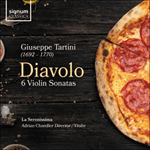
Welcome to Hyperion Records, an independent British classical label devoted to presenting high-quality recordings of music of all styles and from all periods from the twelfth century to the twenty-first.
Hyperion offers both CDs, and downloads in a number of formats. The site is also available in several languages.
Please use the dropdown buttons to set your preferred options, or use the checkbox to accept the defaults.

| Adrian Chandler (violin), La Serenissima» More |
One night I dreamt that I had made a bargain with the Devil for my soul. Everything went at my command—my novel servant anticipated every one of my wishes. Then the idea struck me to hand him my fiddle and to see what he could do with it. But how great was my astonishment when I heard him play with consummate skill a sonata of such exquisite beauty as surpassed the boldest flight of my imagination. I felt enraptured, transported, enchanted; my breath was taken away; and I awoke. Seizing my violin I tried to retain the sounds that I had heard. But it was in vain. The piece I then composed, the Devil’s Sonata, although the best I ever wrote, how far below the one I heard in my dream!
Lalande added that Tartini composed the work in 1713, which is impossibly early given the style of the music. It probably dates from the late 1740s or later. The trill appears in the driving Allegro assai that repeatedly interrupts a gentle Andante—representing, presumably, the sleeping composer. The work is played here from Cartier’s text; it differs in countless ways from the nineteenth-century edition that is still in widespread use.
from notes by Peter Holman © 1992
Lalande ajoute que Tartini composa l’œuvre en 1713, ce qui est impossible étant donné le style de la musique; elle date probablement de la fin des années 1740 au plus tard. Le trille figure dans l’Allegro assai énergique qui interrompt à maintes reprises un tranquille Andante—représentant, on suppose, le compositeur endormi. On a utilisé pour cette exécution le texte de Cartier, qui présente d’innombrables différences avec l’édition du dix-neuvième siècle dont l’usage est encore très répandu.
extrait des notes rédigées par Peter Holman © 1992
Français: Martine Erussard
Eines Nachts träumte mir, ich hätte mit dem Teufel einen Pakt um meine Seele geschlossen. Alles ging nach meinem Kommando—mein neuer Diener wußte im Voraus um jeden meiner Wünsche. Dann kam mir der Gedanke, ihm meine Fiedel zu überlassen und zu sehen, was er damit anzufangen wußte. Aber wie groß war mein Erstaunen, als ich ihn mit vollendetem Geschick eine Sonate von derart erlesener Schönheit spielen hörte, daß meine kühnsten Erwartungen übertroffen wurden. Ich war verzückt, hingerissen, bezaubert; mir stockte der Atem; und ich erwachte. Ich griff zu meiner Violine und versuchte die Klänge nachzuvollziehen, die ich gehört hatte. Doch vergebens. Das Stück, das ich alsdann komponierte, die Teufelssonate, mag das Beste sein, was ich je geschrieben habe, doch wie weit bleibt sie hinter jenem zurück, das ich im Traum gehört habe!
Lalande fügt hinzu, daß Tartini das Werk 1713 komponiert habe, doch das wäre dem Stil der Musik nach unmöglich früh; wahrscheinlich ist es Ende der 1740er Jahre oder später entstanden. Der bewußte Triller taucht in dem drängenden Allegro assai auf, das wiederholt ein sanftes Andante unterbricht—vermutlich eine Darstellung des schlafenden Komponisten. Das Werk wird hier nach Cartiers Vorlage gespielt; diese weist unzählige Unterschiede zur Druckausgabe des 19. Jahrhunderts auf, die immer noch weithin im Umlauf ist.
aus dem Begleittext von Peter Holman © 1992
Deutsch: Anne Steeb/Bernd Müller
 Tartini: Violin Sonatas Tartini: Violin SonatasSometimes considered in the same breath as Vivaldi, Tartini's output differs in being almost exclusively centred on the instrument at which he himself excelled: the violin. The six sonatas here (he wrote over forty, along with a similar number of ...» More |

